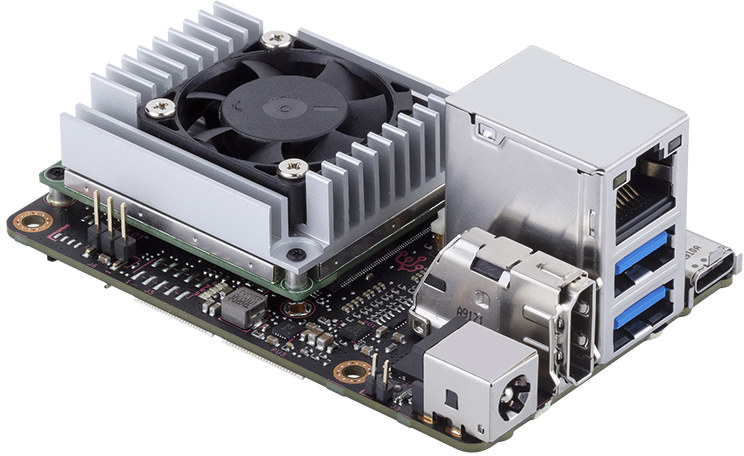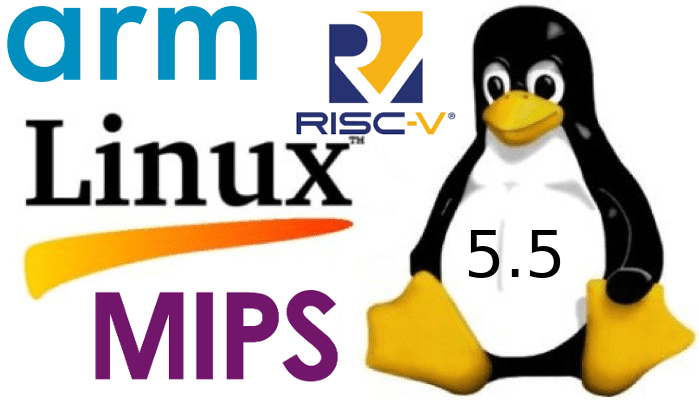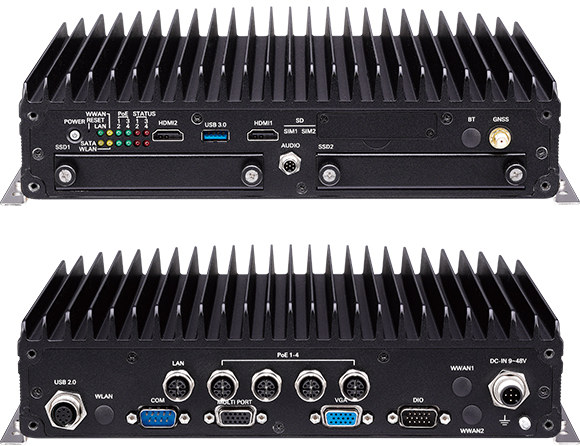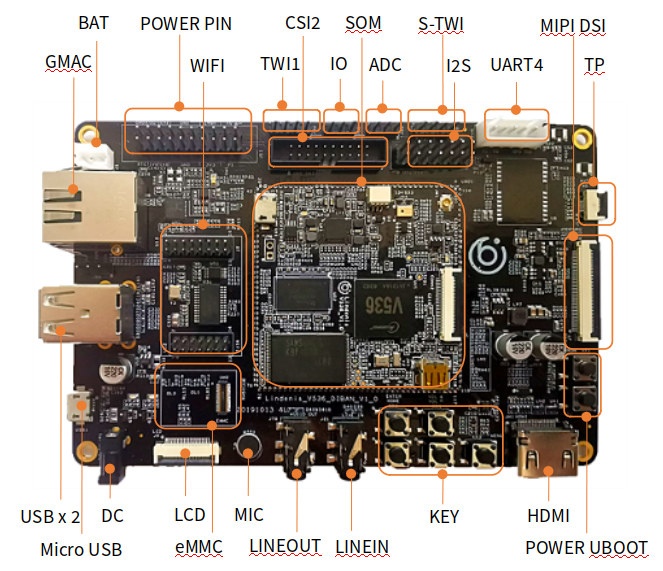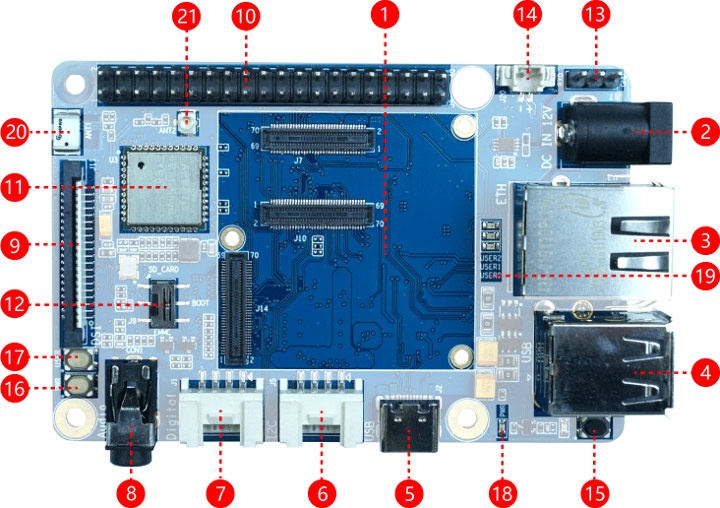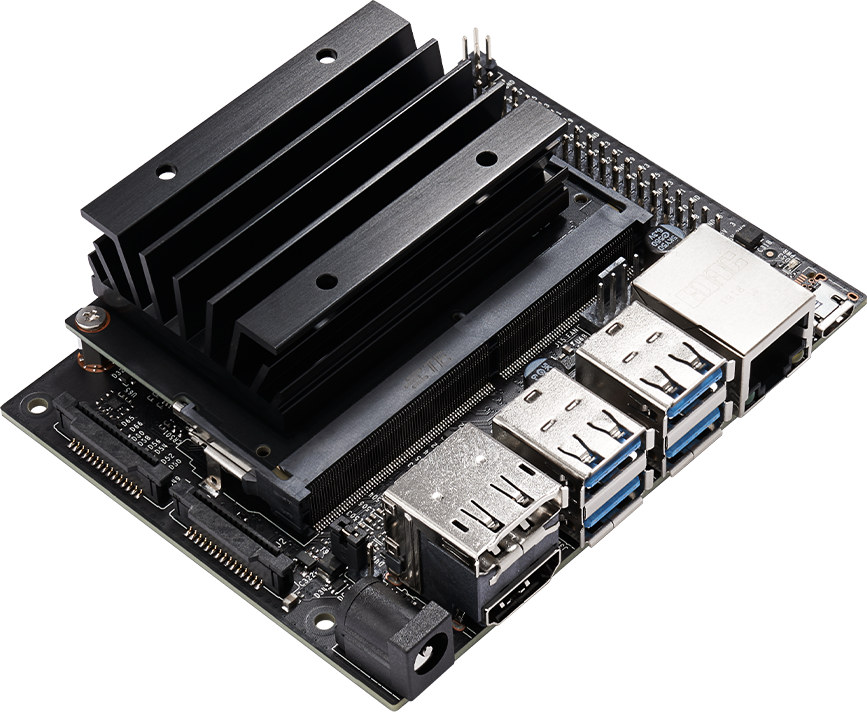ASUS unveiled Tinker Edge T & CR1S-CM-A SBCs based on Google Coral Edge TPU system-on-module featuring both NXP i.MX 8M processor and Google Edge TPU co-processor for AI acceleration in May 2019, but at the time none of the boards were available. But earlier this month, ASUS officially announced the board, and it can now be purchased on various sites including Provantage (~$168.35) and Physical Computing (21,600 JPY ~ $200). It is also listed on Connection for about $198 but currently out of stock. Edge TPU module SoC – NXP i.MX 8M quad-core Arm Cortex-A53 processor with Arm Cortex-M4F real-time core, GC7000 Lite 3D GPU ML accelerator – Google Edge TPU coprocessor delivering up to 4 TOPS System Memory – 1 GB LPDDR4 RAM Storage – 8 GB eMMC Flash memory Wireless Connectivity – Wi-Fi 2×2 MIMO (802.11b/g/n/ac 2.4/5GHz) Bluetooth 4.2 Baseboard Storage – MicroSD card slot Networking – Gigabit […]
Linux 5.5 Release – Main Changes, Arm, MIPS and RISC-V Architectures
Linux 5.5 has just been released by Linus Torvalds: So this last week was pretty quiet, and while we had a late network update with some (mainly iwl wireless) network driver and netfilter module loading fixes, David didn’t think that warranted another -rc. And outside of that, it’s really been very quiet indeed – there’s a panfrost driver update too, but again it didn’t really seem to make sense to delay the final release by another week. Outside of those, it’s all really tiny, even if some of those tiny changes touched some core files. So despite the slight worry that the holidays might have affected the schedule, 5.5 ended up with the regular rc cadence and is out now. That means that the merge window for 5.6 will open tomorrow, and I already have a couple of pull requests pending. The timing for this next merge window isn’t optimal […]
ESP Open Source Research Platform Enables the Design of RISC-V & Sparc SoC’s with Accelerators
FOSDEM 2020 will take place next week, and there will be several interesting talks about open-source hardware and software development. One of those is entitled “Open ESP – The Heterogeneous Open-Source Platform for Developing RISC-V Systems” with an excerpt of the abstract reading: ESP is an open-source research platform for RISC-V systems-on-chip that integrates many hardware accelerators. ESP provides a vertically integrated design flow from software development and hardware integration to full-system prototyping on FPGA. For application developers, it offers domain-specific automated solutions to synthesize new accelerators for their software and map it onto the heterogeneous SoC architecture. For hardware engineers, it offers automated solutions to integrate their accelerator designs into the complete SoC. If we go to the official website, we can see ESP (Embedded Scalable Platform) actually supports both 32-bit Leon3 (Sparc) and 64-bit Ariane (RISC-V) cores, and various hardware accelerators from the platform or third parties. Highlights: […]
NEXCOM In-vehicle Computers Enable 24/7 Monitoring of Trains, Buses, and Trucks
Taiwan based NEXCOM has introduced two new mobile computing solutions specifically designed for transportation with nROK 6222/VTC 6222 Intel Apollo Lake computers enabling 24/7 monitoring of trains, buses, trucks, and other vehicles. The computers come with five Ethernet ports, including four PoE enable, in order to connect IP cameras, and two HDMI output, one VGA output to let drivers monitor the front and back of the vehicle, and passengers view travel-related or other information. NEXCOM nROK 6222/VTC 6222 key features and specifications: SoC – Intel Atom x7-E3950 quad-core Apollo Lake processor clocked at 1.6 GHz / 2.0GHz with Intel HD Graphics 505 System Memory – 4GB DDR3L 1866 SO-DIMM (default) up to 8GB Storage – 2x 2.5″ SATA 3.0 SSD up to 15mm thick, SD card slot, internal USB DOM Video Output – VGA, 2 x HDMI Connectivity nROK 6222 – 1x Gigabit Ethernet (M12) port, 4x Ethernet (M12) ports […]
Lindenis V536 SoM & SBC Targets 4K Camera Applications
Back in summer 2018, we wrote about Lindenis V5 single board computer based on Allwinner V5 quad-core Cortex-A7 processor with two MIPI CSI connectors and designed for 4K cameras. Allwinner has now come up with a new 4K camera processor very similar to V5, since Allwinner V566 comes with two Cortex-A7 cores, and a single MIPI CSI interface, and Lindenis designed a new SBC based on the new processor using a SoM + baseboard design instead. Lindenis V536 specifications: SoM SoC – Allwinner V536 dual-core Cortex-A7 processor @ 1.2 GHz; 4K H.265/H.264 video encoding & decoding @ 30 fps; 28nm process System Memory – 1GB DDR3 Storage – SPI NOR flash or SPI NAND flash, bootable MicroSD card Video Output – Micro HDMI 1.4 port Video Input – MIPI CSI connector Audio – Digital microphone Connectivity – 802.11b/g/n/ac Wi-Fi 5 & Bluetooth 4.2 via AP6255 Baseboard Interface – Castellated holes […]
ODYSSEY-STM32MP157C SBC Feature STMicro STM32MP157C Cortex-A7/M4 SoC
Seeed Studio has been working on a single board computer powered by STMicro STM32MP157C Arm Cortex-A7/M4 microprocessor, comprised of the Raspberry Pi inspired NPi-STM32MP157C baseboard, and SoM-STM32MP157C system-on-module. SoM-STM32MP157C SoM Module specifications: MPU (1) – STMicro STM32MP157C dual-core Arm Cortex-A7 processor @ 650 MHz, and Arm Cortex-M4F MCU System Memory (2) – 512MB DDR3 RAM Storage (4) – 4GB eMMC flash Host Connectors – 3x 70-pin board-to-board connectors with HDMI, USB, Gigabit Ethernet, audio GPIOs, etc… Misc – Power and USER LEDs PMU (3) – STPMIC1A power management IC Dimensions – 38mm x 38mm The module is said to targets consumer and industrial applications, white goods, medical equipment, and wearable devices. NPi-STM32MP157C baseboard Key features and specifications: SoM Support – Compatible with SOM-STM32MP157C described above Storage – MicroSD card slot Display I/F – 1x MIPI DSI interface Audio – 3.5mm audio jack, WM8960 audio codec Camera I/F – 1x […]
MNT Reform 2 Open Source DIY Arm Linux Modular Laptop Coming Soon (Crowdfunding)
We first covered MNT Reform in fall of 2017, when it was a prototype for a DIY and modular laptop powered by NXP i.MX 6QuadPlus processor, and with plans to eventually use i.MX 8 hexa-core processor. Last year they designed several beta units of Reform to get feedback for a dozen users, and have now fully redesigned the laptop based on an NXP i.MX 8M system-on-module with the crowdfunding campaign expected to go live in February on Crowd Supply. MNT Reform 2 specifications: SoM – Boundary Devices Nitrogen8M SOM with SoC – NXP i.MX 8MQuad quad-core Cortex-A53 processor @ 1.5 GHz, 1x Arm Cortex-M4F real-time core Vivante GC7000Lite 3D GPU System Memory – 4GB LPDDR4 Storage – Probably none Networking – Atheros Ethernet MAC chip (AR8035) 200 pin SO-DIMM edge connector exposing USB 3.0, PCIe, MIPI DSI, etc… Dimensions – 67.6mm x 48.4mm Motherboard Storage – SD card slot, M.2 […]
NVIDIA Jetson Nano Developer Kit-B01 Gets an Extra Camera Connector
Launched in March 2019, NVIDIA Jetson Nano developer kit offered an AI development platform for an affordable $99. The kit is comprised of Jetson Nano module and a carrier board, and the version I received last November ended with “A02”. Jetson Nano developer kit is now getting updated with B01 carrier board that adds an extra MIPI CSI connector and other few changes, including compatibility with NVIDIA Jetson Nano production module (with eMMC flash instead of MicroSD card). Jetson Nano developer kit-B01 specifications: B01 Jetson Nano CPU Module 128-core Maxwell GPU Quad-core Arm A57 processor @ 1.43 GHz System Memory – 4GB 64-bit LPDDR4 @ 25.6 GB/s Storage – microSD card slot Video Encode – 4K @ 30 | 4x 1080p @ 30 | 9x 720p @ 30 (H.264/H.265) Video Decode – 4K @ 60 | 2x 4K @ 30 | 8x 1080p @ 30 | 18x 720p @ 30 […]


